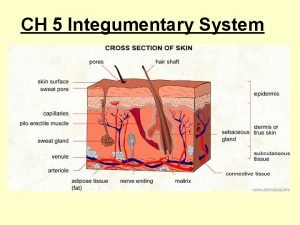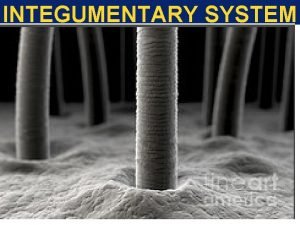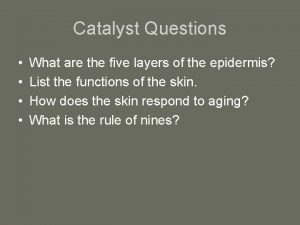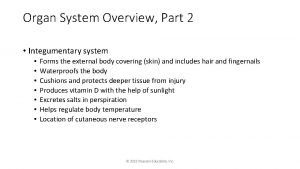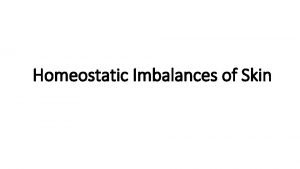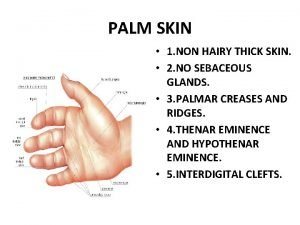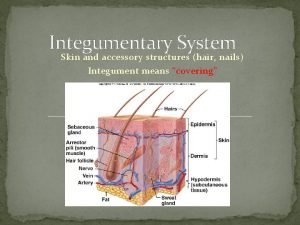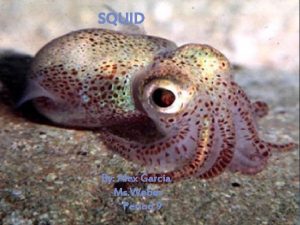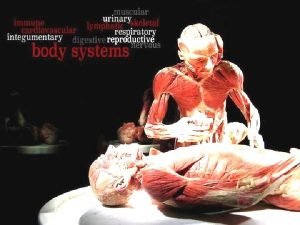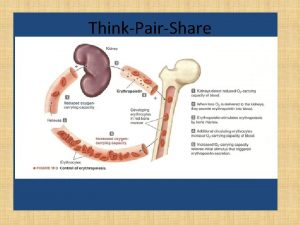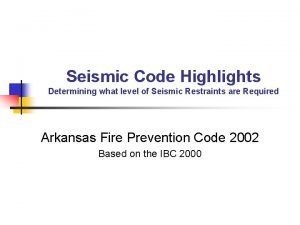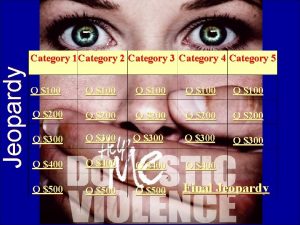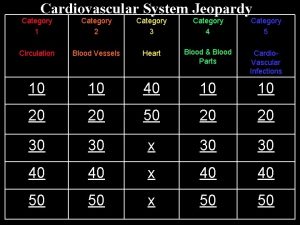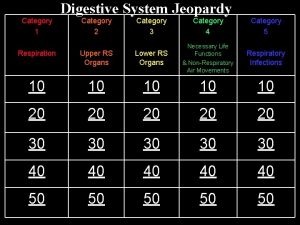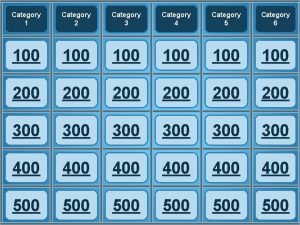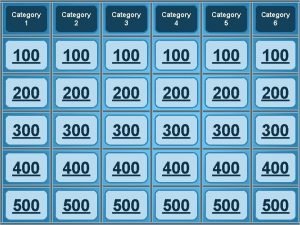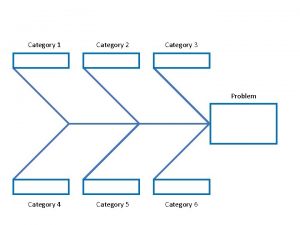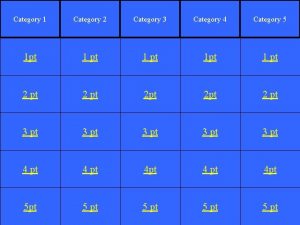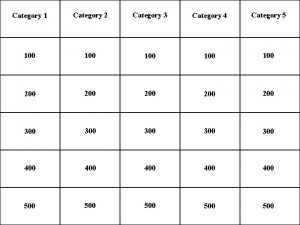Integumentary System Jeopardy Category 1 Introduction to Integumentary



















































- Slides: 51

Integumentary System Jeopardy Category 1 Introduction to Integumentary Sys Category 2 Skin Layers Category 3 Skin Colors Category 4 Skin Appendages Category 5 Skin Infections 10 10 10 20 20 20 30 30 30 40 40 40 50 50 50

The categories of epithelial tissue membranes are: A. synovial, mucous, &cutaneous B. mucous, cutaneous, and serous C. synovial, mucous, and serous D. cutaneous, synovial, and serous Category 1 - 10 points Answer. . .

The categories of epithelial tissue membranes are: A. synovial, mucous, &cutaneous B. mucous, cutaneous, and serous C. synovial, mucous, and serous D. cutaneous, synovial, and serous Category 1 - 10 points Home

The skin is a: A. cutaneous membrane B. mucous membrane C. synovial membrane D. serous membrane E. basement membrane Category 1 - 20 points Answer. . .

The skin is a: A. cutaneous membrane B. mucous membrane C. synovial membrane D. serous membrane E. basement membrane Category 1 - 20 points Home

A. Pericardium B. Peritoneum C. Pleura 1____ This type of serous membrane lines around the heart. 2____ This type of serous membrane lines around the lungs. 3____ This type of serous membrane lines around the abdominal cavity. Category 1 - 30 points Answer. . .

A. Pericardium B. Peritoneum C. Pleura 1__A__ This type of serous membrane lines around the heart. 2__C__ This type of serous membrane lines around the lungs. 3__B__ This type of serous membrane lines around the abdominal cavity. Category 1 - 30 points Home

Which of the following is a connective tissue membrane A. serous membrane B. pleural membrane C. cutaneous membrane D. mucous membrane E. synovial membrane Category 1 - 80 points Answer. . .

Which of the following is a connective tissue membrane A. serous membrane B. pleural membrane C. cutaneous membrane D. mucous membrane E. synovial membrane Category 1 - 80 points Home

Which of the following is NOT a true statement about the papillary layer of the dermis: A. it produces the pattern for fingerprints B. it is located immediately beneath the epidermis C. it is the deepest layer of the skin D. it contains nerve endings that respond to touch and temperature stimuli Answer. . . Category 1 - 50 points

Which of the following is NOT a true statement about the papillary layer of the dermis: A. it produces the pattern for fingerprints B. it is located immediately beneath the epidermis C. it is the deepest layer of the skin D. it contains nerve endings that respond to touch and temperature stimuli Category 1 - 50 points Home

Epidermal cells that are continuously replaced as a result of being continually rubbed off are: A. stratum lucidum cells B. stratum spinosum cells C. stratum corneum cells D. stratum basale cells Answer. . . Category 2 - 10 points

Epidermal cells that are continuously replaced as a result of being continually rubbed off are: A. stratum lucidum cells B. stratum spinosum cells C. stratum corneum cells D. stratum granulosum cells Category 2 - 10 points Home

Which layer has no blood supply of its own: A. the epidermis only B. subcutaneous connective tissue only C. the dermis only E. both the epidermis and the dermis Category 2 - 20 points Answer. . .

Which layer has no blood supply of its own: A. the epidermis only B. subcutaneous connective tissue only C. the dermis only E. both the epidermis and the dermis Category 2 - 20 points Home

The hypodermis consists of: A. adipose tissue B. dense fibrous connective tissue C. simple columnar epithelium D. loose connective tissue Answer. . . Category 2 - 30 points

The hypodermis consists of: A. adipose tissue B. dense fibrous connective tissue C. simple columnar epithelium D. loose connective tissue Category 2 - 30 points Home

Melanocytes are found in the: A. stratum lucidum B. stratum corneum C. stratum granulosum D. stratum basale Double Jeopardy Category 2 - 40 • 2 = 80 points Answer. . .

Melanocytes are found in the: A. stratum lucidum B. stratum corneum C. stratum granulosum D. stratum basale Category 2 80 points Home

Which of the following is the correct sequence in layers of the epidermis from deepest to superficial: A. stratum spinosum A. ) A, D, C, E, B B. stratum lucidum B. ) E, D, C, B, A C. stratum granulosum C. ) D, A, C, B, E D. stratum basale D. ) A, B, C, E, D E. stratum corneum E. ) B, A, D, C, E Category 2 - 50 points Answer. . .

Which of the following is the correct sequence in layers of the epidermis from deepest to superficial: A. stratum spinosum A. ) A, D, C, E, B B. stratum lucidum B. ) E, D, C, B, A C. stratum granulosum C. ) D, A, C, B, E D. stratum basale D. ) A, B, C, E, D E. stratum corneum E. ) B, A, D, C, E Category 2 - 50 points Home

What is the major pigment found in the skin called? A. melanin B. carotene C. jaundice D. keratin Answer. . . Category 3 - 10 points

What is the major pigment found in the skin called? A. melanin B. carotene C. jaundice D. keratin Category 3 - 10 points Home

Skin color is determined by: A. amount of carotene in the subcutaneous tissue B. pigments in the epidermis(melanin) C. the degree of oxygenation of the blood D. all of the above Answer. . . Category 3 - 20 points

Skin color is determined by: A. amount of carotene in the subcutaneous tissue B. pigments in the epidermis (melanin) C. the degree of oxygenation of the blood D. all of the above Category 3 - 20 points Home

DOUBLE JEOPARDY! When skin has a blue appearance due to poor oxygenation it is called: A. pallor B. erythema C. Jaundice D. Hematoma E. Cyanosis Answer. . . Category 3 - 60 points

DOUBLE JEOPARDY! When skin has a blue appearance due to poor oxygenation it is called: A. pallor B. erythema C. Jaundice D. Hematoma E. Cyanosis Category 3 - 60 points Home

Double Jeopardy: While playing soccer, Cody was kicked in the shin. The resulting mark on his skin is an example of what skin color? A. hematoma B. Pallor C. Erythema D. Jaundice E. yellow and red Category 3 - (40 pt x 2) 80 points Answer. . .

Double Jeopardy: While playing soccer, Cody was kicked in the shin. The resulting mark on his skin is an example of what skin color? A. Hematoma B. Pallor C. Erythema D. Jaundice E. Yellow and Red Category 3 - (40 pt x 2) 80 points Home

A yellow color to the skin can indicate a problem with what major organ? A. spleen B. heart C. small intestine D. liver Category 3 - 50 points Answer. . .

A yellow color to the skin can indicate a problem with what major organ? A. spleen B. heart C. small intestine D. liver Category 3 - 50 points Home

Although you get while swimming, a tough protein within the skin prevents it from soaking up moisture like a sponge. This substance is: A. B. C. D. keratin melanin carotene serous fluid Category 4 - 10 points Answer. . .

Although you get while swimming, a tough protein within the skin prevents it from soaking up moisture like a sponge. This substance is: A. B. C. D. keratin melanin carotene serous fluid Category 4 - 10 points Home

Finger-like upward projections of the dermis into the epidermis are called: A. hair follicles B. dermal papillae C. Meissner's corpuscles D. hair bulbs Category 4 - 20 points Answer. . .

Finger-like upward projections of the dermis into the epidermis are called: A. hair follicles B. dermal papillae C. Meissner's corpuscles D. hair bulbs Category 4 - 20 points Home

Sweat glands in the axillary and genital areas are: A. eccrine glands B. sebaceous glands C. apocrine glands D. porous glands E. sudoriforal glands Category 4 DOUBLE JEOPARDY - 60 points Answer. . .

Sweat glands in the axillary and genital areas are: A. eccrine glands B. sebaceous glands C. apocrine glands D. porous glands E. sudoriforal glands Category 4 DOUBLE JEOPARDY - 60 points Home

Fingernails are: A. derived from osseous tissue B. genetically controlled by a "delayed action" gene C. formed from a different embryonic layer D. a modification of the epidermis Answer. . . Category 4 - 40 points

Fingernails are: A. derived from osseous tissue B. genetically controlled by a "delayed action" gene C. formed from a different embryonic layer D. a modification of the epidermis Category 4 - 40 points Home

The apocrine sweat glands are: A. most responsible for odor in humans B. found primarily in the axillary and genital areas C. become active at puberty D. all of the above E. none of the above Answer. . . Category 4 - 50 points

The apocrine sweat glands are: A. most responsible for odor in humans B. found primarily in the axillary and genital areas C. become active at puberty D. all of the above E. none of the above Category 4 - 50 points Home

Which of the following homoeostatic imbalances is caused by skin exposure to chemicals: A. athlete's foot B. contact dermatitis C. impetigo D. cyanosis Answer. . . Category 5 - 10 points

Which of the following homoeostatic imbalances is caused by skin exposure to chemicals: A. athlete's foot B. contact dermatitis C. impetigo D. cyanosis Category 5 - 10 points Home

Inflammation of the hair follicles and sebaceous glands is (are) called: A. boils B. impetigo C. psoriasis D. alopecia Category 5 - 20 points Answer. . .

Inflammation of the hair follicles and sebaceous glands is (are) called: A. boils B. impetigo C. psoriasis D. alopecia Category 5 - 20 points Home

Which type of skin cancer is slow growing and least malignant? A. malignant melanoma B. basal cell carcinoma C. squamous cell carcinoma Category 5 - 30 points Answer. . .

Which type of skin cancer is slow growing and least malignant? A. malignant melanoma B. basal cell carcinoma C. squamous cell carcinoma Category 5 - 30 points Home

What type of burn is characterized by a gray-white color and involves all layers of the skin? A. first-degree burns B. second-degree burns C. third-degree burns D. partial-thickness burns Category 5 - 40 points. Answer. . .

What type of burn is characterized by la gray-white color and involves all layers of the skin? A. first-degree burns B. second-degree burns C. third-degree burns D. partial-thickness burns Category 5 - 40 points Home

Sneha has developed flaky, silvery scales over hands and elbows. She knew she had a chance of having this condition because it is hereditary. Which condition does she most likely have? A. dermatitus B. impetigo C. ringworm D. psorasis Answer. . . Category 5 - 50 points

Emily has developed flaky, silvery scales over hands and elbows. She knew she had a chance of having this condition because it is hereditary. Which condition does she most likely have? A. dermatitis B. impetigo C. ringworm D. psoriasis Category 5 - 50 points Home
 Erate category 2
Erate category 2 Jeopardy category names
Jeopardy category names Potpourri jeopardy
Potpourri jeopardy Potpourri category jeopardy
Potpourri category jeopardy Epidermis
Epidermis Integumentary system vocabulary
Integumentary system vocabulary Integumentary system of a pig
Integumentary system of a pig Pengertian sistem integumen
Pengertian sistem integumen The integumentary system facts
The integumentary system facts Exercise 7 the integumentary system
Exercise 7 the integumentary system Integumentary system vocab
Integumentary system vocab Integument medical term
Integument medical term The integumentary system
The integumentary system Integumentary system assessment
Integumentary system assessment Integumentary system analogy
Integumentary system analogy The integumentary system
The integumentary system The integumentary system
The integumentary system Integumentary system components
Integumentary system components Effects of aging on the integumentary system
Effects of aging on the integumentary system Section 36-3 the integumentary system
Section 36-3 the integumentary system Integumentary system
Integumentary system Integumentary system
Integumentary system Unit 3 integumentary system a&p chapter 5
Unit 3 integumentary system a&p chapter 5 Examples of homeostatic imbalances of the skin
Examples of homeostatic imbalances of the skin Dermal structure
Dermal structure 6 functions of the integumentary system
6 functions of the integumentary system Anatomy and physiology of psoriasis
Anatomy and physiology of psoriasis Interesting facts about the urinary system
Interesting facts about the urinary system Integumentary system
Integumentary system Integumeny
Integumeny Integumentary system cpt coding guidelines ppt
Integumentary system cpt coding guidelines ppt Integumentary system the integument epidermis coloring page
Integumentary system the integument epidermis coloring page Palm without skin
Palm without skin Nails integumentary system
Nails integumentary system Integumentary system
Integumentary system Excretory and integumentary system
Excretory and integumentary system Squid integumentary system
Squid integumentary system Integumentary system foldable
Integumentary system foldable Chapter 6 integumentary system
Chapter 6 integumentary system Charge floor stock drugs
Charge floor stock drugs File system category
File system category Chapter 36 skeletal muscular and integumentary systems
Chapter 36 skeletal muscular and integumentary systems Free nerve endings and encapsulated
Free nerve endings and encapsulated How do you pronounce integumentary
How do you pronounce integumentary Organization of the lymphatic system
Organization of the lymphatic system Defination of life role
Defination of life role Turfgrass pest management (category 3a practice test)
Turfgrass pest management (category 3a practice test) Planning phase of the nursing process
Planning phase of the nursing process Pseudo sinusoidal fetal heart rate pattern
Pseudo sinusoidal fetal heart rate pattern Seas application example category 4
Seas application example category 4 Atar and seas calculator
Atar and seas calculator Seismic design category
Seismic design category












